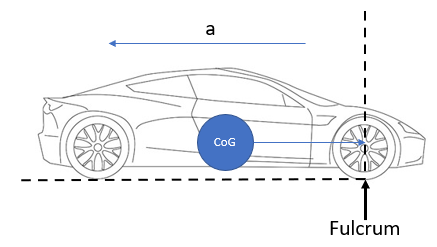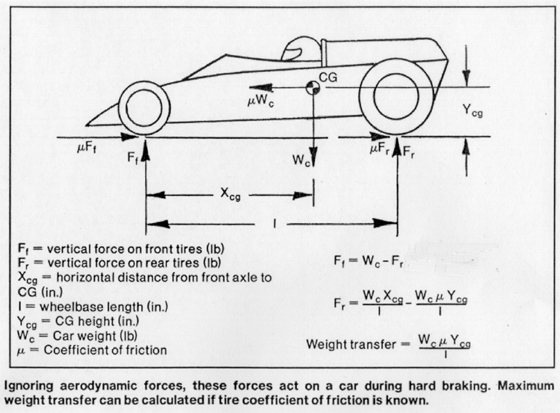Why do they feel slow?
Discussion
bigothunter said:
Thanks for your explanation.
But could you explain why working the rear wheels harder gives much better braking results...
Front wheels lose mechanical grip because it's all the tyres can do at this point. They are braking at their full capacity.But could you explain why working the rear wheels harder gives much better braking results...
Rear wheels lose grip partially because they get lifted off the ground.
Distributing the weight/force on the 4 wheels instead of two wheels that already can't cope helps.
ZesPak said:
bigothunter said:
Thanks for your explanation.
But could you explain why working the rear wheels harder gives much better braking results...
But could you explain why working the rear wheels harder gives much better braking results...
ZesPak said:
Front wheels lose mechanical grip because it's all the tyres can do at this point. They are braking at their full capacity.
Suggest researching tyre longitudinal force versus vertical load. Weight transfer increases mechanical tyre grip. However ultimate tyre capacity eventually becomes significant, which means moving to a larger section tyre when weight transfer is large.ZesPak said:
Rear wheels lose grip partially because they get lifted off the ground.
Likewise less vertical load reduces longitudinal tyre force. Fiesta on high mu surface only generated 18% rear longitudinal force under 1.0g braking. According to your theory, FWD cars would have terrible braking performance. But contribution simply shifts to the front tyres.ZesPak said:
Distributing the weight/force on the 4 wheels instead of two wheels that already can't cope helps.
Not quite that simple...ZesPak said:
bigothunter said:
Not quite that simple...
Thank you for that elaboration.Can you explain why a Model S outbrakes all it's more performance-oriented competitors despite being heavier than most?
I appreciate that it might not be "quite that simple"... but the results are there.
Do EVs have some clever way of optimising brake force apportioning F/R without stability problems arising? Can MaxTorque come to the rescue?
Do you have a reference to these brake test result please? Could shed some light on the subject.
ZesPak said:
Thank you for that elaboration.
Can you explain why a Model S outbrakes all it's more performance-oriented competitors despite being heavier than most?
I appreciate that it might not be "quite that simple"... but the results are there.
Perhaps a bigger mass gives a better ratio of sprung to unsprung weight, so the suspension can be better at keeping the tyres uniformly loaded?Can you explain why a Model S outbrakes all it's more performance-oriented competitors despite being heavier than most?
I appreciate that it might not be "quite that simple"... but the results are there.
Or perhaps their ABS just works better? By 'ABS' I'm including the regen braking.
Possibly Tesla are simply better at software than most vehicle makers.
Or maybe they found some sticky tarmac for their tests.
Or maybe the extra weight got their tyres hotter?
Just a few thoughts on this weight transfer topic:
Longer wheelbase has same effect as lower mass centre - weight transfer reduces under braking and acceleration.
Wider track has same effect when cornering.
Given sufficient grip, geometry defines ultimate limits. Bike doing a 'stoppie' cannot generate more braking force without nasty consequences. Similarly a car on two wheels cannot corner any faster.
Weight transfer longitudinally or laterally influences tyre section required. More weight transfer means bigger tyres for the same vehicle mass.
But that's just my understanding so open to criticism and ridicule
Longer wheelbase has same effect as lower mass centre - weight transfer reduces under braking and acceleration.
Wider track has same effect when cornering.
Given sufficient grip, geometry defines ultimate limits. Bike doing a 'stoppie' cannot generate more braking force without nasty consequences. Similarly a car on two wheels cannot corner any faster.
Weight transfer longitudinally or laterally influences tyre section required. More weight transfer means bigger tyres for the same vehicle mass.
But that's just my understanding so open to criticism and ridicule

GT9 said:
Tesla Plaid had/has some issues with braking, I'm not sure it does actually outperform rivals.
It does. The brakes just overheat after a couple of goes as they can't cope. But for the first couple of times, it does.The "issues with braking" are mainly overheating and the fact that it is indeed the first production car to do this:
GT9 said:
In fact I believe it has a unique characteristic that it can accelerate faster than it can brake.
"engineering explained" did a video on it, according to him it basically boils down to Tesla doing the software better than Bosh.He also mentioned that it might be easier to rapidly adjust the electromotor compared to the brakes.
bigothunter said:
But that's just my understanding so open to criticism and ridicule 
I think most if not all your points are valid, but I was responding to this:
bigothunter said:
Your technical explanation of how lower mass centre than AMG GT 4, BMW M5, Porsche Panamera Turbo S improves stopping distance, would be appreciated...
Whilst you aren't convinced, I'm pretty sure that if we raise the CoG in any of these cars, braking will suffer for the reasons I stated.bigothunter said:
Just a few thoughts on this weight transfer topic:
Longer wheelbase has same effect as lower mass centre - weight transfer reduces under braking and acceleration.
Does it? I can see moving the weight backwards does, but I'd say it's mostly in CoG (and of course suspension). I don't see how lengthening the wheelbase can positively affect braking if you take suspension out of the equation.Longer wheelbase has same effect as lower mass centre - weight transfer reduces under braking and acceleration.
I sort of fixed the image. Moving the CoG around will definitely change the amount of braking the rear wheels get to do.

ZesPak said:
bigothunter said:
Longer wheelbase has same effect as lower mass centre - weight transfer reduces under braking and acceleration.
Does it? I can see moving the weight backwards does, but I'd say it's mostly in CoG (and of course suspension). I don't see how lengthening the wheelbase can positively affect braking if you take suspension out of the equation.I sort of fixed the image. Moving the CoG around will definitely change the amount of braking the rear wheels get to do.


GT9 said:
Tesla Plaid had/has some issues with braking, I'm not sure it does actually outperform rivals.
In fact I believe it has a unique characteristic that it can accelerate faster than it can brake.
I am not sure being able to accelerate harder than braking is unique to the Tesla, I suspect it's true of some dragsters?In fact I believe it has a unique characteristic that it can accelerate faster than it can brake.
You can spin a wheel and heat the rubber with more control than you can allow it to slip under braking?
Also there was an Eastern Bloc motorbike which when road tested by a magazine in the 70s had a braking distance of something like 240ft from 30mph...
In 'real road' conditions, things like long wheel base might help due to making the effect of road bumps smaller?
As with drag racing and demo bike abuse, the actual figures you get will vary with tyre temp, tarmac, phase of the moon and what-have-you, so playing Top Trumps over a fraction of a second or a metre is probably best left to the kids.
ZesPak said:
OutInTheShed said:
I am not sure being able to accelerate harder than braking is unique to the Tesla, I suspect it's true of some dragsters?
The Plaid is unique in that regards as a production car. The motor torque controller can detect slip and adjust torque at near light speed. That's certainly a step up from lumpy ICE traction control efforts.
ZesPak said:
OutInTheShed said:
I am not sure being able to accelerate harder than braking is unique to the Tesla, I suspect it's true of some dragsters?
The Plaid is unique in that regards as a production car. 
Dragsters.. You couldn't make this stuff up could you?
SWoll said:
ZesPak said:
OutInTheShed said:
I am not sure being able to accelerate harder than braking is unique to the Tesla, I suspect it's true of some dragsters?
The Plaid is unique in that regards as a production car. 
Dragsters.. You couldn't make this stuff up could you?
 'feels slow' will have a long life on PH
'feels slow' will have a long life on PH700-1200hp and over 1000nm torque is roughly in the region of slow. Every day is a school day!
TheDeuce said:
It's a seriously impressive stat. And demonstrates the level of torque control an EV has over it's motors Vs the relatively crude technology that is friction braking.
The motor torque controller can detect slip and adjust torque at near light speed. That's certainly a step up from lumpy ICE traction control efforts.
Not to mention it can do that on the front axle and both rear wheels individually. Torque vectoring is a lot easier when you don't have to deal with 3 differentials.The motor torque controller can detect slip and adjust torque at near light speed. That's certainly a step up from lumpy ICE traction control efforts.
SWoll said:
But I bet it "feels" slow though?


Dragsters.. You couldn't make this stuff up could you?
 I reigned in my response earlier, but exactly what I was thinking. I remember this exact convo when someone was trying to convince the Model S wasn't that impressive as an "alpha GTR" (?) has 1400hp, beats it in a straight line and costs only slightly more.
I reigned in my response earlier, but exactly what I was thinking. I remember this exact convo when someone was trying to convince the Model S wasn't that impressive as an "alpha GTR" (?) has 1400hp, beats it in a straight line and costs only slightly more.Gassing Station | EV and Alternative Fuels | Top of Page | What's New | My Stuff


